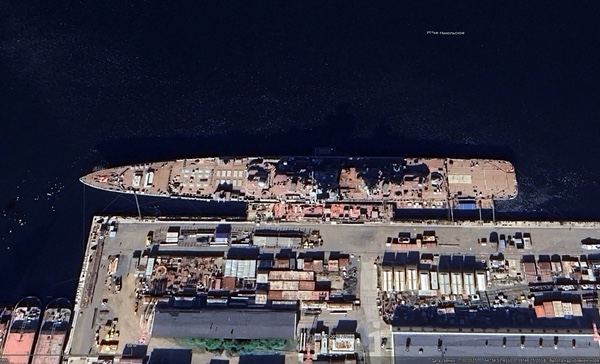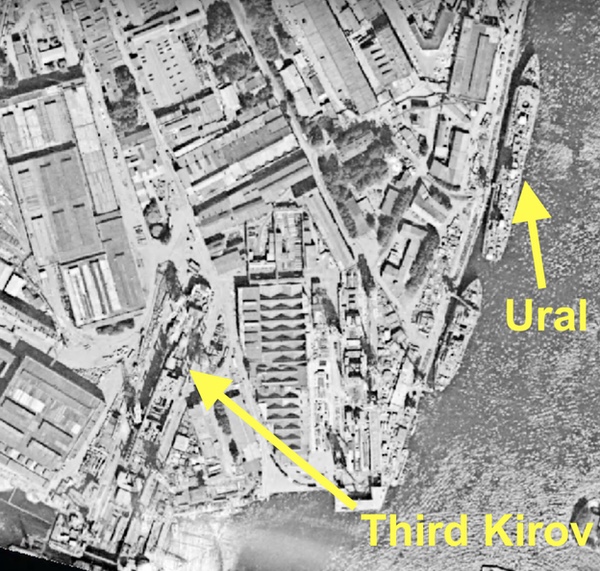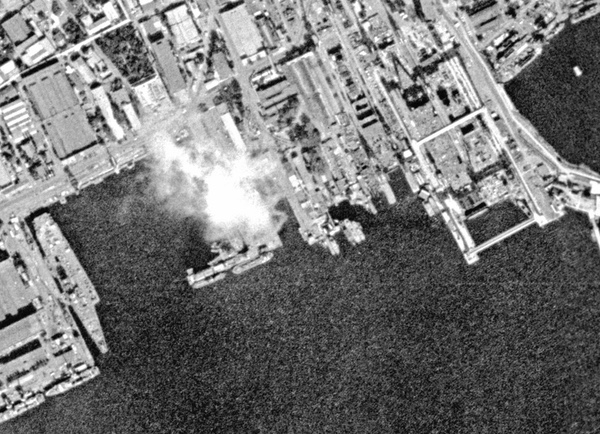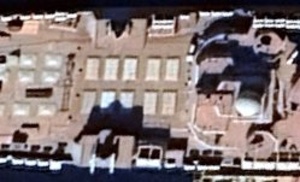
September 2025 Airbus satellite image of the nuclear-powered battlecruiser Admiral Nakhimov. Originally launched in the 1980s, the ship spent nearly 30 years in mothballs but has recently been upgraded. (credit: Airbus)
by Dwayne A. Day
Monday, September 29, 2025
Recently, a commercial imagery satellite photographed the Russian nuclear-powered battlecruiser Admiral Nakhimov at pierside after undertaking new sea trials. The satellite imagery provides new details about the ship’s modernization after a very long and expensive refit period. It reveals the large number of missiles that the ship is now equipped to fire, making it, by some measures, the most powerful surface warship in the world. The ship first came to the attention of Western intelligence agencies in satellite photos taken more than 40 years ago, but then it posed a greater threat than it does today.

A 1984 HEXAGON reconnaissance satellite image of the Leningrad (now St. Petersburg) shipyard where the Kirovs were constructed. At left is the third Kirov under construction. The ship was eventually named Kalinin and in the 1990s was renamed Admiral Nakhimov. At right is the large communications ship Ural. (credit: courtesy of Harry Stranger)
Spotting the monster
In early 1974, American reconnaissance satellites spotted the first signs of a new major surface warship under construction at a Leningrad (now St. Petersburg) shipyard. Over the next several years they photographed the ship as it took shape, indicating that it would be the Soviet Union’s first nuclear-powered surface warship. The ship launched in late 1977, sliding down the ramp into the Neva River. It was the largest surface combatant in the world at that time, bigger than any American cruiser. High-resolution reconnaissance images showed that it had twenty large hatches on its bow covering what were obviously big missiles, and intelligence analysts determined that it was intended to attack American aircraft carriers. Other hatches concealed anti-aircraft missiles. The ship’s pagoda-like superstructure was covered with numerous radar and communications antennas. Eventually, the US intelligence community determined that the ship was named Kirov. (See “HEXAGON vs. Kirov: American satellite reconnaissance and the Soviet Union’s most powerful warship,” The Space Review, September 23, 2024.)
Over the next several years, American satellites spotted the Kirov undergoing sea trials, staying within Soviet waters where it was safe from observation by the West’s aircraft and ships—although not American satellites. In 1980 Kirov finally sailed into the open sea and was tracked by NATO forces.
Kirov soon became overloaded with weapons systems and its mission changed from submarine hunting to attacking American aircraft carriers. But at least one Soviet naval designer considered it to be absurd, too expensive, and too much ship for the mission.
As Kirov was undergoing sea trials, American satellites spotted a second ship of the same class under construction in the Leningrad shipyard. In 1982, a secret intelligence report noted that this vessel was slightly different than the Kirov, lacking the twin-tube SS-N-14 missile launcher and the addition of a possible Udaloy-type surface-to-air missile system. This second ship also had a twin 130mm gun mount replacing two 100mm gun mounts positioned aft on Kirov. Upon launching, it was named Frunze. At that time no evidence of construction of a third Kirov was observed.
The Soviet Union paused construction of new Kirovs to build an unusual nuclear-powered ship that was even larger than the battlecruisers. This ship was intended to intercept American satellite communications. It was launched in 1983. It was moored nearby the construction yard undergoing installation of its large satellite domes while work began on the third Kirov battlecruiser.
In July 1984, the last successful HEXAGON reconnaissance satellite mission, number 1219, photographed the Leningrad shipyard. The satellite photo returned to Earth a few days later revealed the third Kirov under construction. It was nearly identical to the first two ships that had been launched in 1977 and 1980. Although this was not the first satellite image of the facility showing the new construction, it added to the growing body of evidence indicating that the Soviet Union was continuing to build these large warships after launching the large communications vessel Ural a year before. It was the Kirovs more than any other factor that led the U.S. Navy to reactivate its four Iowa-class battleships in the 1980s.
By 1986, the official Department of Defense publication Soviet Military Power noted that the third Kirov was nearing completion and would likely launch in 1986, and that a fourth ship was under construction. When the third ship entered service in 1988, it was named Kalinin and it was assigned to the Northern Fleet. Eventually a fourth and final Kirov was launched.

A 1984 HEXAGON reconnaissance satellite photo of the large shipyard in what is now illegally occupied Crimea where the Soviet Union built its aircraft carriers. The carrier/cruiser Baku is at left, still fitting out. The carrier under construction at right was eventually named Admiral Kuznetsov. Kuznetsov has been undergoing modernization for many years now and is likely to be scrapped. (credit: courtesy of Harry Stranger)
The Nakhimov Building
Some information about the development of the Kirovs has been published in Russian naval history books. One revelation was that the ship was originally intended to be an anti-submarine cruiser like its predecessor, the Kara class. However, it was nuclear-powered and, as the hull got bigger, various factions within the Soviet Navy argued for inclusion of their new weapons systems. Kirov soon became overloaded with weapons systems and its mission changed from submarine hunting to attacking American aircraft carriers. But at least one Soviet naval designer considered it to be absurd, too expensive, and too much ship for the mission.
This assessment proved accurate, particularly with the collapse of the Soviet Union. The Kirovs required large crews and were costly to operate. All four ships were renamed after the dissolution of the USSR. Kirov suffered a nuclear reactor accident in 1990 and was pulled from service and in 1992 was renamed Admiral Ushakov. Frunze, renamed Admiral Lazarev, was pulled from service in 1994 and decommissioned four years later. Kalinin was renamed Admiral Nakhimov in 1992, but the ship was moored by 1997. Only the fourth ship, Pyotr Velikiy, remained operational. Starting in 2021, Admiral Lazarev was scrapped, and satellite photos showed the ship being cut up in a floating drydock. Admiral Ushakov is also supposed to be scrapped, but the reactor accident will make this difficult to accomplish.
Admiral Nakhimov sat at dockside throughout the 2000s. In 2014, the Russian government announced that it was beginning modernization of the ship. Despite that, Nakhimov’s refurbishment took over a decade. It was put in drydock and some photos and videos were released showing the ship’s outdated weaponry and radars being stripped. But the pace of refurbishment was incredibly slow. In the US Navy, the derogatory term for a ship that spends too much time in port due to mechanical problems is a “building.” Ships are supposed to be at sea, not at dock. For nearly three decades, Nakhimov was a building.

When originally built, Kalinin had twenty large hatches forward for anti-ship missiles. New satellite photos reveal that they have been replaced with ten eight-cell cruise missile launchers, for a total of eighty cruise missiles. (credit: Airbus)
The dinosaur sails again
It was not until early 2025 that the Russian government announced that the ship’s two nuclear reactors had been activated. In August 2025, Admiral Nakhimov was finally photographed heading into the White Sea on trials—the first time in 27 years. However, the ship did not appear to be under its own power but towed by tugs. It spent three weeks in the White Sea and then was towed back into port, possibly indicating that the propulsion system is not yet working.
One of the ironies of the modern space age is that powerful tools that used to only be accessible to the American intelligence community are now available to anybody with a computer. Although several photos of Admiral Nakhimov were posted to social media in August, they all showed the ship from the side, which did not reveal any notable changes to the ship’s weapons systems.
In the US Navy, the derogatory term for a ship that spends too much time in port due to mechanical problems is a “building.” For nearly three decades, Nakhimov was a building.
In July 2024, a commercial satellite photo had shown the ship back in the water, but still incomplete. In September 2025, a commercial satellite photo of Admiral Nakhimov became publicly available. The satellite photo reveals that Admiral Nakhimov’s original 20 vertical launchers for P-700 (SS-N-19) Granit anti-ship cruise missiles have been replaced by ten eight-cell modules for 80 modern cruise missiles. Forward of these are 12 eight-cell rotary launchers housing 96 S-300FM (SA-N-20) surface-to-air missiles. Additional photos—via satellites, or those taken by Western maritime surveillance aircraft, or released by the Russian government—will be necessary to determine other changes to the vessel.
The core of the modernization program was a plan to install no fewer than 176 vertical launch tubes. This would be more than any other surface combatant or submarine in the world. At least in terms of missiles, it would make Admiral Nakhimov the most powerful surface combatant at sea. However, photos cannot reveal if all those vertical launch tubes are loaded, or if the ship’s new electronic systems work properly. The sheer size of the vessel could be considered a weakness. Why spend so much money, and load so many weapons, onto a single vessel? As submariners like to say, there are two kinds of naval vessels: subs and targets. Admiral Nakhimov is a very big target.
The Admiral Nakhimov spent forever undergoing refurbishment, but may not be the most notorious large Russian warship. The aircraft carrier Admiral Kuznetsov went into refurbishment in 2017. During the work, the carrier suffered multiple fires and a drydock sinking. By early 2021, analysis of photos of the carrier suggested that work on the vessel had more or less stopped in the previous 12 months. In February 2023, the Kuznetsov finally departed its drydock at the Sevmorput Naval Shipyard in Russia’s northwestern Murmansk region. Two months later there were reports that many members of the crew had been sent to fight in Ukraine. In summer 2025, a Russian newspaper reported that Kuznetsov was now likely to be scrapped.
When—if—Admiral Nakhimov is declared fully operational, it is expected to eventually replace the only operational ship, Pyotr Velikiy, in the Northern Fleet. Pyotr Velikiy will probably be scrapped due to its high operating costs and its obsolete systems.
Note: we are now moderating comments. There will be a delay in posting comments and no guarantee that all submitted comments will be posted.
